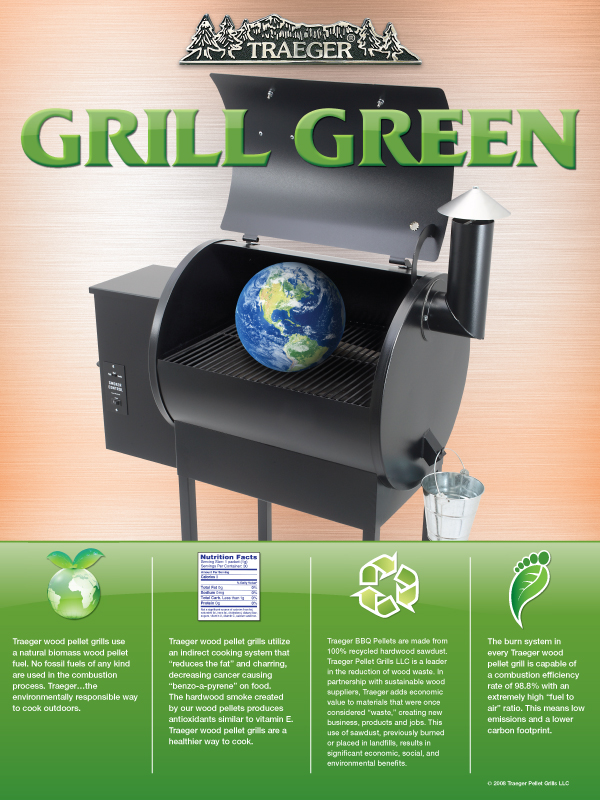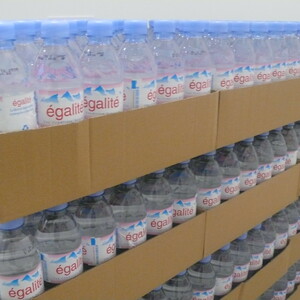Image Credit: Traeger
Image Credit: Traeger Ever have the feeling you're getting snowed by a “green” marketing claim? It probably falls into one of these nine forms, from the “red herring” to the “bait and switch.”
Image Credit: From Greenwashing Index, via webecoist.com's post on worst greenwashers.
I am going to go out on a limb here, but I would bet that sometime in the last 24 hours you have received a marketing message centered around how “green,” how “environmentally friendly,” or (if it’s really serious), how “sustainable” something is.
Whether or not we believe in these claims is a matter of some debate. The 2011 Cone Green Gap Trend Tracker found that an 97% of Americans believe they know what common environmental marketing claims such as “green” or “environmentally friendly” mean. Apparently we have seen enough of these claims to know what they’re all about.
But do we? Our interpretations are often inaccurate, according to the researchers. More than two in five of us (41%) erroneously believe that these terms mean a product has a beneficial impact on the environment. Only about one in three (29%) understand that these terms more accurately describe products with reduced environmental impact compared with competing products.
That study seems to indicate a lot of willingness to believe what the marketers tell us. However, a study from the U.K. has a somewhat different story to tell. In that study, by the Carbon Trust, only 7% of respondents take companies at their word when they say that they are reducing their climate impacts. More than half (53%) say they are concerned that companies make one-time improvements to win publicity, before returning to business as usual. Did the study ask different questions, or are the Brits more skeptical?
Sorting out the green from the greenwash has become a necessity for U.S. builders and designers. To help, my colleague Jennifer Atlee and I have developed a guide to common problems: we cleverly named it “Nine Types of Greenwashing” when we included it in our dare-I-say essential report on green building product certifications. We also have eagle eyes for these types of issues when we are setting standards and selecting green products for our GreenSpec product guide. Here are the nine types.
1.) Green by Association
A company slathers itself and its marketing thoroughly in environmental terms and images so that even if its products have no environmental benefits, consumers associate them with positive environmental attributes. Examples: Gas-guzzling cars and trucks pictured in remote natural settings, or housing developments named for natural features that they have destroyed, e.g., “Conifer Lane.”
2.) Lack of Definition
Marketing for a product makes an environmental claim that sounds good to the consumer but is too vague or general. Examples: a product is described as being non-toxic or without hazardous chemicals, when these definitions are only meaningful in specific contexts — many chemicals are non-toxic to the touch but harmful to ingest, for example. A radiant barrier paint product is advertised as having an incredibly high R-value, but the ad neglects to mention that it only insulates that well when installed on NASA spacecraft that see thousands of degrees of temperature differences.
3.) Unproven Claims
Environmental claims are made by a company, but the company cannot or will not provide evidence to back them up. Examples: A company claims to have implemented a new manufacturing process to increase its product’s recycled content, but doesn’t certify the claim. A manufacturer claims to have eliminated hazardous ingredients from a product but claims that due to trade secrets, it can’t reveal any specifics.
4.) The Non Sequitur
A company uses a valid claim about a product as the basis for a further claim that is not warranted, but may on its surface appear to be reasonable. Example: A manufacturer accurately claims that its product is resistant to mold growth, but also implies or states that thus using the product improves the health of occupants — a claim that has some logic, but that really needs to be evaluated separately.
5.) Forgetting the Life Cycle, a.k.a. The Red Herring
A company chooses one easily understood aspect of a product’s environmental profile to improve and highlight, while ignoring other significant impacts — sometimes out of ignorance; sometimes as an intentional effort to divert attention. Example: A company touts the high recycled content in its countertops, but it uses a lot of embodied energy and carbon to make them, and uses binders with human health impacts.
6.) Bait and Switch
A company heavily promotes the environmental attributes of a single product, while selling and manufacturing a bulk of otherwise similar products that lack the same environmental attributes. Example: A company sells cedar shingles that are certified as sustainably harvested, earning acclaim, but produces the product in such little volume at such an increased price that most of its sales resulting from the attention are for non-certified products.
7.) Rallying Behind a Lower Standard
A product earns an apparently valid, third-party certification — but the product’s manufacturer or trade association had influenced the development of the relevant standard in a way that makes the certification less meaningful than it appears. Example: The forest products industry catches hell in the early 1990s for environmental damages caused by logging, but rather than join the rigorous green standard that has already been developed, the industry bands together to create its own program with similar, but much more vague standards.
8.) Reluctant Enthusiast
A company lobbies against new environmental measures, claiming that they will be too costly. Particularly if it’s losing the battle however, it hedges its bets, publicly embracing similar measures — while continuing to resist them behind the scenes. Example: “Beyond Petroleum.”
9.) Outright Lying
Either intentionally or inadvertently, a company bends the truth, or simply ignores it. Example: A company claims that a product is beneficial to the environment, when it’s actually just less bad. Or a manufacturer claims that its product contains recycled content based on reuse of scrap within a manufacturing line — but that actually doesn’t meet the definition of recycled.
I want to thank Terrachoice, which publishes the “Seven Sins of Greenwashing,” for helping inspire this list, which Jennifer and I first wrote over three years ago for our article, Behind the Logos: Understanding Green Product Certifications. We like their list, too, but we see some distinctions that we like to highlight.
What are examples of questionable green claims that you’ve seen recently? Want help evaluating them? Let me know.
Tristan Roberts is Editorial Director at BuildingGreen, Inc., in Brattleboro, Vermont, which publishes information on green building solutions. You can learn more at www.BuildingGreen.com.
Last week’s Energy Solutions post: New and Improved Cotton Insulation Still Doesn’t Work
Weekly Newsletter
Get building science and energy efficiency advice, plus special offers, in your inbox.
















6 Comments
Thanks
Tristan, I'm no longer in a classroom every day, but I cc'd it to a friend who quiickly replied that he's going to use it as part of his intro-logic course this fall. He'll give credit, and I assume you won't mind.
A thought: many consumers who aren't dedicated environmentalists but who are interested in understanding what it is they are buying read/subscribe 'Consumer Reports.' If one of you folks would get in touch with them, your "list" is the sort of thing they love. I wouldn't be surprised if they adopted -- or, more likely, adapted -- the material.
Getting the word to those consumers who want to be aware seems to be the next big step.
Thanks,
Joe
What's Illigitimate About Traeger's Claims?
I don't know if each of Traeger's claims are correct but will agree that cooking with natural wood -vs- chemical-laced charcoal briquettes is "more green".
Using the wood byproduct -vs- throwing it in the trash is certainly "more green" in my estimation.
Something Traeger did not indicate, something that I do is use the ash from my wood-fired grill with other natural materials to make fertilizer for my vegetable and fruit gardens...very green and tastes good..
I'll readily admit that there is some pollution when I cook with wood and wood charcoal. Most of the produce from my garden is eaten raw so can I get some "green credits" for that?
Now to my point; Many of us in the green building movement run the risk of discouraging builders from producing better products with a Holier then thou / "I'm greener than you" attitude. It seems that anything with which I have a personal disagreement I call "greenwashing." I've seen many builders in recent years simply throw in the towel on green building...so I try to keep them in the game.
Don't get me wrong, I teach about various greenwashing in seminars too. I love the debate over whether a product or service is truly green. These arguments encourage us to get better at what we provide. Many times it depends on the lens through which we each look... and what we personally stress.
One guy says "green" is about the environment, another about durability, another about comfort, and yet another about personal health...Finally someone says it's about saving energy. The answer is that it's all of the above and it's hard to "have it all", especially when up front costs can be quite expensive.
I say if someone recognizes the "green-ness" of their own product or service, even if it's only incremental or a small portion of their product line, I want to cheer them on and coach them to make constant improvements. Let's welcome them aboard and then encourage them in ways more green.
We should evaluate whether they are operating in good faith or in bad faith. If bad faith, shame on them. They may deserve exposure to the light. If good faith, they'll be open to our encouragement.
Let's be good stewards with the gifts of the earth that God gave to us and speak charitably.
Good job with the list and article Alex and Tristan. Good food for thought.
Response to Tom
Tom,
I'm the editor who chose the Traeger ad photo, not Tristan -- so don't blame Tristan if you don't think the ad is a good illustration of his comments on greenwashing.
I'd say that Traeger's assertion that their charcoal is better than some other types of charcoal may have merit -- but it's basically misleading, because choosing a different charcoal will not make a serious dent in most family's carbon footprint, and because grilling over charcoal probably releases more carbon than other methods of cooking. (The argument is complicated, but a recent N.Y. Times column noted -- somewhat clumsily -- that propane grilling may be three lives less damaging to the atmosphere than using charcoal.)
I don't have a strong argument in favor of grilling with propane. But I'm sure of the fact that the route to saving our planet doesn't require us to buy more charcoal grills or to burn more charcoal.
Response to Martin
Martin,
Excellent points...and then we can say that grilling with natural gas would even be better (due to the less polluting transportation costs of natural gas)...and then electric grilling is even when the electricity is provided by a hydroelectric power plant...and then eating raw (my personal goal) is even better.
But, I don't grill with an electric grill because the experience is not as enjoyable...I grill with propane and slow cook using wood charcoal. And many slow cookers are very efficient these days (like my ceramic cooker...not a Traeger) and use little charcoal and wood.
By the way, what do you think about the Pilot pen advertisement that keeps popping up on this page??? using recycled bottles??? Is that legitimate or is there any "greenwashing"? Is there room for incrementalism in the movement?
greenwashing
http://www.ecolabelindex.com/ecolabels : This website lists every third party certification for goods, products and services. A very useful source when looking to see if something is third party reviewed. Lots of products you won't find certified claim to be the greenest!
which certifications are credible?
William, that is a good list of certifications, but the question becomes, which of those certifications are credible, and which apply to products that are relevant to you? For a detailed review of certifications and standards that are relevant to builders, including a "quick take' for each on how good it is, I recommend BuildingGreen's special report, Green Building Product Certifications.
Log in or create an account to post a comment.
Sign up Log in